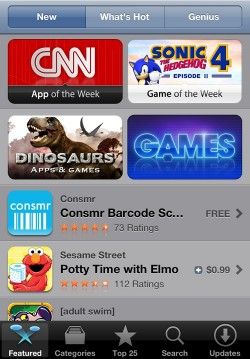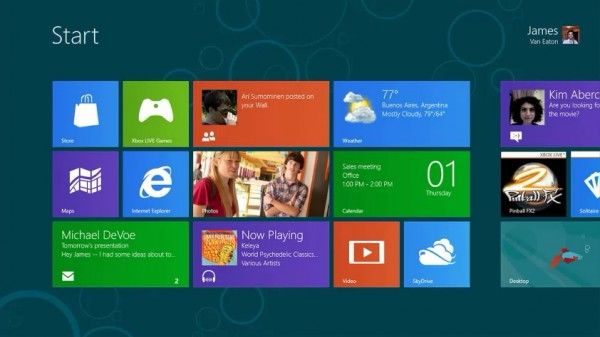Fast forward to today: the new game in town is the curated application store. Instead of letting anyone run any program on a given platform, Apple has shown decisively that a ‘locked-down’ and carefully curated library of apps can make a successful platform that earns top marks in consumer satisfaction; it turns out that making it easy for consumers to pay developers leads to high quality programs and happy customers — who’d have thought!? Apple’s seminal App Store now has 585,000+ applications available, with over $4 billion having been paid to developers (an additional 30% of that figure being paid to Apple, of course). Still, programs aren’t the only part of the equation — a great operating system also needs a modern user-centric design and a consistent user-interface (UI) — not something easily accomplished by a software goliath like Microsoft that’s been in free-for-all mode since the beginning.
Part of Microsoft’s issue is legacy support. There is so much software out there — millions of programs — that have been built to work within the computing paradigm that Microsoft created with Windows. Much of the business world has adopted the Windows platform for their essential software. Many of the systems that make the world turn round are based on custom programs that are written for Windows. Many huge companies rely on the Windows environment for all of their digital needs — inventory tracking, expense reports, project management, HR, CMS, etc. etc. etc. — all of this is based on what Windows has been so far. It is far from practical for Microsoft to throw it all out the window and restart with a new consumer-focused computing paradigm.
But Microsoft is fully aware of the need to bring Windows up to date with the sort of user experiences people have come to expect from smartphones and tablets. With that awareness they’ve taken what might be their only opportunity to make the necessary changes while still providing the legacy support that many industries rely upon; they’re splitting Windows 8 in half. The forthcoming eighth edition of Windows will have the standard ‘desktop’ interface, that has its essential roots in Windows 95, while at the same time will include a new half of Windows — the ‘Metro’ interface — which Microsoft hopes will satisfy the expectations of a modern smartphone/tablet user. The question remains, can they pull it off?
Microsoft has been hard at work on Windows 8, and following the updates on the Microsoft Developer Network’s ‘Building Windows 8’ blog gives me some real hope that Microsoft could provide an operating system that is slick and easy to use — one that matches the elegance of the Ultrabook hardware that it will be running on.
One of my biggest issues with Windows is the degradation of performance over time. If you’ve ever ‘fixed’ your computer by doing a fresh install of Windows, then you know what I’m talking about. Windows just seems to get slower over time, and the only good way to fix it seems to be a fresh install. Microsoft knows this and is hoping to fix it. According to an insightful BW8 post authored by Jensen Harris, Director of Program Management for the Windows 8 User Experience team:
Much of what has been pejoratively called ‘winrot’ over the years is due to overzealous downloaded programs overstepping their bounds and installing system services and updaters and background tasks and all sorts of things that slow down the system.
These assets are far too easily abused or accidentally misused—there is a better way.
New Windows 8 apps cannot alter system settings for the most part (with the exception of a few specifically architected capabilities, such as enabling location services or using the webcam, which require user consent.)
Continue Reading on Page 3













um where is page three
This centralized metro app store of the future isn’t all cupcakes & lollipops. You can pretty much say goodbye to emulators, P2P clients, CD/DVD/BR rippers, etc.
Many people believe that Apple, Microsoft, & others are looking to someday get rid of all non-market programs & completely control the ecosystem in order to please various Entertainment industries & governments.
Those people are correct.
I’m not defending windows, but the “confusing error message” examples are ASUS messages, not windows. ASUS is absolutely awful as far as English is concerned, both in their software and documentation. It almost seems like they are using online translation tools to save a few bucks on an English-speaking technical writer?
Might i suggest linux :)
I use efficiently gentoo on a pre-ultrabook era laptop (acer timeline X 14′) and had no trouble. Intel has good drivers on GNU/Linux. The downside s you can’t play all windows games under wine…
I’d really recommend giving ubuntu or linux mint a spin.
I actually tried Ubuntu 12.04 a few days back but ran into trouble. I restarted twice, and it seemed to work fine, but after that it wouldn’t boot and I don’t really know why. Probably a disk error though.
I’ve tried a few versions, and all of them had graphics that just didn’t seem sharp. Like it wasn’t the right resolution, even though it was.
They are making big strides when it comes to user friendliness.